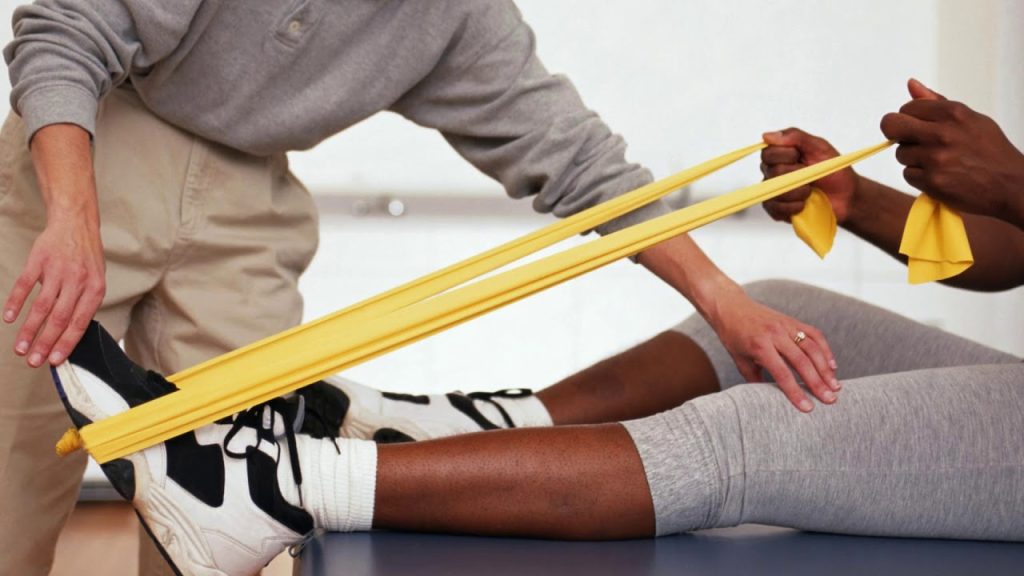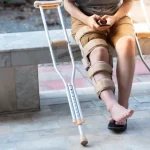Updated on February 13, 2024
Medically reviewed by Laura Campedelli, DPT
Fact checked by Nick Blackmer
A broken ankle can severely limit your ability to perform basic functional tasks like running and walking. This painful injury can cause loss of lower extremity strength, range of motion, and pain. These impairments can make performing your normal everyday activities difficult or impossible.
You may benefit from physical therapy (PT) after a broken ankle to help you fully recover functional mobility and to return to your previous level of activity.
Ankle Fracture Symptoms and Causes
Your ankle is a joint where the talus bone of the foot connects to the tibia (shin bone) and fibula of the leg. Trauma here can cause a break in any or all of these bones and significant pain usually results immediately after the injury.

Ankle fractures almost always occur during a traumatic event to the body. Automobile accidents, falls, and sports injuries can all lead to ankle fractures. Common signs of an ankle fracture include pain, swelling, bruising, and an inability to bear weight on the broken ankle.1
If you suspect you have a broken bone in your ankle, your first step should be to seek medical attention immediately. Failure to do so may result in a significant loss of function.
Treatment
While at the hospital following an ankle fracture, your healthcare provider may attempt to reduce the fracture. Fracture reduction is the term used to describe how a bone is fixed or set after it’s broken.

The pieces of bone must be put in close proximity to one another so that healing can occur. Fracture reduction is essential to ensure that the bone heals properly and that permanent functional loss or deformity is avoided.
After your ankle fracture is reduced, your ankle will most likely be placed in a cast. This immobilizes the ankle and allows the bones to heal properly.2 Many times after an ankle fracture, you will require some sort of assistive device to walk.
You may also be under specific weight-bearing restrictions. Be sure to ask your healthcare provider how much weight you are allowed to put on your ankle as it heals.
Physical Therapy
Once your fracture is reduced and immobilized, you may be referred to physical therapy to learn how to possibly use an assistive device like crutches, a cane, or a walker. Your physical therapist should also be able to help you understand your weight-bearing restrictions.
Gentle exercise for the muscles of the knee and hip may be performed to ensure that the muscle groups that help you walk do not get too weak while the fracture heals. If you are in a cast or a brace, most likely you will not be performing exercises for your ankle.
After your fractured ankle has healed, your healthcare provider will remove the cast and allow you to bear more weight on your ankle. You may be using an assistive device like a quad cane or crutches to walk.
At this point, your physical therapist can fully evaluate your ankle to help provide the proper treatment. Components of the ankle evaluation may include:
- Gait
- Range of motion
- Strength
- Swelling
- Pain
The evaluation may also include a car assessment if you had an open reduction internal fixation (ORIF) surgery.
After a thorough evaluation, your physical therapist can begin providing treatment. He or she may use therapeutic modalities like heat, ice, or electrical stimulation to help treat swelling or pain around your ankle.
Video: “Ankle Joint Recovery after Fracture”
EXERCISES FOR THE ANKLE JOINT. SET №6E IS AIMED AT STRENGTHENING OF THE MUSCLES AND IMPROVEMENT OF PROPRIOCEPTION AND STABILITY OF THE ANKLE AND ENTIRE LOWER LIMB. MID STAGE
For additional information about the recovery process after an ankle fracture, you can watch a video demonstrating exercises and rehabilitation recommendations.
Exercises
An ankle fracture exercise program should be the main component of your ankle rehabilitation following a fracture.2 Be sure to follow your physical therapist’s directions closely and ask questions if you have any.
Exercises for ankle fracture rehabilitation may include:
- Exercises for ankle range of motion
- Ankle strengthening exercises
- Hip and knee exercises (to help improve walking ability)
- Balance and proprioception exercises
- Exercise to improve functional mobility and walking ability
You’ll most likely be required to perform a home exercise program for your broken ankle. This program may continue for several months after physical therapy has stopped, and the program may be an important component in your long-term rehab success.
Wolff’s law states that bone grows and remodels in response to the stress that is placed upon it. Your physical therapist can help prescribe exercises that apply the right stress in the correct direction to ensure that maximal bone healing occurs and that your fractured ankle will function properly.
Gait training will also be important following an ankle fracture. Your physical therapist can help you progress from using an assistive device to walking independently.
If you have had surgery to reduce your ankle fracture, there may be scar tissue around the incision. Your physical therapist can perform scar tissue massage and mobilization to help improve the mobility of the scar. He or she can also teach you how to perform scar massage techniques on your own.
Video: “Post-traumatic rehabilitation of gait disorders“
EXERCISES FOR POST-TRAUMATIC CORRECTION AND REHABILITATION OF GAIT. INITIAL STAGE – SET 1
For additional information about Post-traumatic rehabilitation of gait disorders you can watch a video demonstrating exercises and rehabilitation recommendations.
How Long Will Physical Therapy Last?
Everyone heals differently, and everyone’s ankle fracture injury is different. Your physical therapist should discuss with you your overall prognosis with your ankle fracture rehab. This prognosis typically depends on how well your ankle is moving when you first start rehab.
In general, physical therapy for a broken ankle lasts about 6 to 8 weeks. Your personal experience with PT may be shorter or longer depending on your specific injury.
Continuing your home exercise program is a component of your rehabilitation. Being diligent with it can help you regain function and get back to the activities you have been missing.
By Brett Sears, PT
Brett Sears, PT, MDT, is a physical therapist with over 20 years of experience in orthopedic and hospital-based therapy.
Summary
An ankle fracture can lead to significant loss of function and limit your ability to walk, run, or participate fully in work and recreational activities. Physical therapy after an ankle fracture can help you improve mobility and help you safely return to normal activity and function.
FREQUENTLY ASKED QUESTIONS
When will I be able to walk after a broken ankle?
If you don’t need surgery, you might be able to walk on your own within six to eight weeks. If your fracture did require surgery, you may get a walking cast after two weeks; four to six weeks later, you may be able to apply some weight and be moved to a cast with a walker or crutches. It may then be a few more weeks before you can fully bear your weight and walk without any aids.
Learn More When Can I Start Running After an Ankle Fracture?
What exercises should I do once I’m out of an ankle cast?
Begin with range of motion exercises. A physical therapist can maneuver your ankle at first. Then you will begin exercises on your own such as pointing your toes and moving your foot in and out. These may be slightly painful as you get used to moving the joint again, but they should not cause severe or lasting pain.

Demo versions of GHRS sets of exercises for the Lower Limb Problems and Post-traumatic rehabilitation of gait disorders on YouTube
You can find more information about the Lower Limb Problems and Post-traumatic rehabilitation of gait disorders in our BLOG
Our website presents sets of exercises for rehabilitation of the ankle joint and gait disorders in the following four areas:
-
EXERCISES FOR THE ANKLE JOINT. SET №5 IS AIMED AT STRETCHING THE MUSCLES (IMPROVEMENT OF FLEXIBILITY OF THE MUSCULAR APPARATUS) AND INCREASE OF THE RANGE OF JOINT MOVEMENT
-
EXERCISES FOR THE ANKLE JOINT. SET №6D IS AIMED AT STRENGTHENING OF THE MUSCLES AND IMPROVEMENT OF PROPRIOCEPTION AND STABILITY OF THE ANKLE AND ENTIRE LOWER LIMB. INITIAL STAGE
-
EXERCISES FOR THE ANKLE JOINT. SET №6E IS AIMED AT STRENGTHENING OF THE MUSCLES AND IMPROVEMENT OF PROPRIOCEPTION AND STABILITY OF THE ANKLE AND ENTIRE LOWER LIMB. MID STAGE
-
EXERCISES FOR THE ANKLE JOINT. SET №6F IS AIMED AT STRENGTHENING OF THE MUSCLES AND IMPROVEMENT OF PROPRIOCEPTION AND STABILITY OF THE ANKLE AND ENTIRE LOWER LIMB. ADVANCED STAGE
-
EXERCISES FOR POST-TRAUMATIC CORRECTION AND REHABILITATION OF GAIT. INITIAL STAGE – SET 1
-
EXERCISES FOR POST-TRAUMATIC CORRECTION AND REHABILITATION OF GAIT. MIDDLE STAGE – SET 2
-
EXERCISES FOR POST-TRAUMATIC CORRECTION AND REHABILITATION OF GAIT. ADVANCED STAGE – SET 3
-
EXERCISES FOR POST-TRAUMATIC CORRECTION AND REHABILITATION OF GAIT. VERY ADVANCED STAGE – SET 4
Sources
https://www.verywellhealth.com/physical-therapy-after-ankle-fracture-2696531
- National Library of Medicine: MedlinePlus. Broken bone.
- American Academy of Orthopaedic Surgeons. Ankle fractures (broken ankle).










